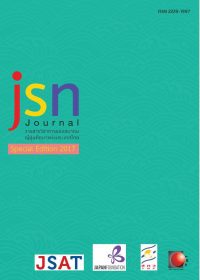Transforming Japan into a Gender-Equal Society
Main Article Content
Abstract
The problem of low birth rates, confounded with the ageing population, has been aggravated to the degree that it could undermine Japan’s future stability. Recognizing its enormity in 1990, the Japanese government attempted to address the problem by introducing the Basic Act for Gender Equal Society (男女共同参画社会基本法)in 1999, followed by the implementation of the Basic Plan for Gender Equality (男女共同参画基本計画) to put the Basic Act into practice.
This article studies the Japanese government’s attempt to transform Japan into a gender-equal society through the enforcement of the Basic Act for Gender Equal Society and the implementation of the Basic Plan for Gender Equality. Work-Life Balance is investigated as one of the strategic measures aimed to implement the Basic Plan.
Eleven indices considered to reflect the effectiveness of the Work-Life Balance measure of the Basic Plan were reviewed in light of their respective targeted figures. The results indicated that such indices could be grouped into three categories: (1) one consisting of indices with a high tendency of achieving their targeted figures; (2) one with indices that could meet their respective targets, provided that special measures are implemented; and (3) one with indices that are distantly lagging behind and that are unlikely to meet their goals by the pre-determined deadlines. In addition, a cross-sectional analysis of these indices revealed that, despite the overall working hours demonstrating a downward trend—suggesting that more time can be dedicated to family, the ultimate ideal of achieving a work-life balance looked elusive as Japanese men still play a limited domestic role, leaving almost all of the child-rearing responsibilities to their female counterparts.
Article Details
ข้อความและข้อคิดเห็นต่างๆ ในบทความเป็นของผู้เขียนบทความนั้นๆ ไม่ใช่ความเห็นของกองบรรณาธิการหรือของวารสาร jsn Journal
References
ปิยวรรณ อัศวราชันย์. (2559). กฎหมายว่าด้วยโอกาสการจ้างงานที่เท่าเทียมกันของผู้หญิงญี่ปุ่น: 3 ทศวรรษแห่งการเปลี่ยนแปลง.วารสารเครือข่ายญี่ปุ่นศึกษา, 6(1), 34-52.
Boling, P. (1998). Family policy in Japan. Journal of Social Policy, 27(2), 173-190.
Ministry of Justice, Japanese Law Translation. (2012). Basic Act for Gender Equal Society. Retrieved from http://www.japaneselawtranslation.go.jp/law/detail/?ft=1&re=02&dn=1&x=42&y=7&co=01&ia=03&ky=basic+act+for+gender+equal+society&page=1
Nihon Keizai Shimbun. (2016). 出生率、2015年は1.46に上昇 21年ぶり高水準. 日本経済新聞. Retrieved from http://www.nikkei.com/article/DGXMZO02656230T20C16A5I00000
杉橋やよい (2015). 「第4章 労働条件. In 伊藤陽一(Ed.), 『女共同参画統計データブック―日本の女 性と男性-2015 』(pp.49-62). ぎょうせい
内閣府男女共同参画局, 7 女性に対するあらゆる暴力の根絶. (n.d.). Retrieved from http://www.gender.go.jp/about_danjo/basic_plans/1st/2-7r.html
内閣府男女共同参画局, 基本計画. (n.d.). Retrieved from http://www.gender.go.jp/about_danjo/basic_plans/index.html
内閣府男女共同参画局, 第1部 基本的考え方. (n.d.). Retrieved from http://www.gender.go.jp/about_danjo/basic_plans/1st/1.html#anc_1_2
内閣府男女共同参画局, 第3次男女共同参画基本計画(平成22年12月17日決定. (n.d.). Retrieved from http://www.gender.go.jp/about_danjo/basic_plans/3rd/index.html
内閣府男女共同参画局, 第3次男女共同参画基本計画における成果目標の動向. (2015). Retrieved from http://www.gender.go.jp/about_danjo/seika_shihyo/pdf/numerical_targets_h270619.pdf
内閣府男女共同参画局,第4次男女共同参画基本計画(平成27年12月25日決定. (n.d.). Retrieved from http://www.gender.go.jp/about_danjo/basic_plans/4th/index.html
内閣府男女共同参画局, 第4次男女共同参画基本計画における成果目標の動向. (2016). Retrieved from http://www.gender.go.jp/about_danjo/seika_shihyo/pdf/numerical_targets_h280531.pdf
内閣府男女共同参画局, 男女共同参画基本計画. (n.d.). Retrieved from http://www.gender.go.jp/about_danjo/basic_plans/2nd/honbun.html
内閣府男女共同参画局, 男女共同参画基本計画について. (n.d.). Retrieved from http://www.gender.go.jp/about_danjo/basic_plans/1st/index.html
内閣府男女共同参画局, 男女共同参画推進本部の設置根拠(閣議決定. (n.d.). Retrieved from http://www.gender.go.jp/kaigi/honbu/konkyo.html
内閣府男女共同参画局, 「男女共同参画社会」って何だろう?. (n.d.). Retrieved from http://www.gender.go.jp/about_danjo/society/index.html
坂東 眞理子 (2009) .『日本の女性政策: 男女共同参画社会と少子化対策のゆくえ』 ミネルヴァ書房.


